The Cost of Higher Housing Costs
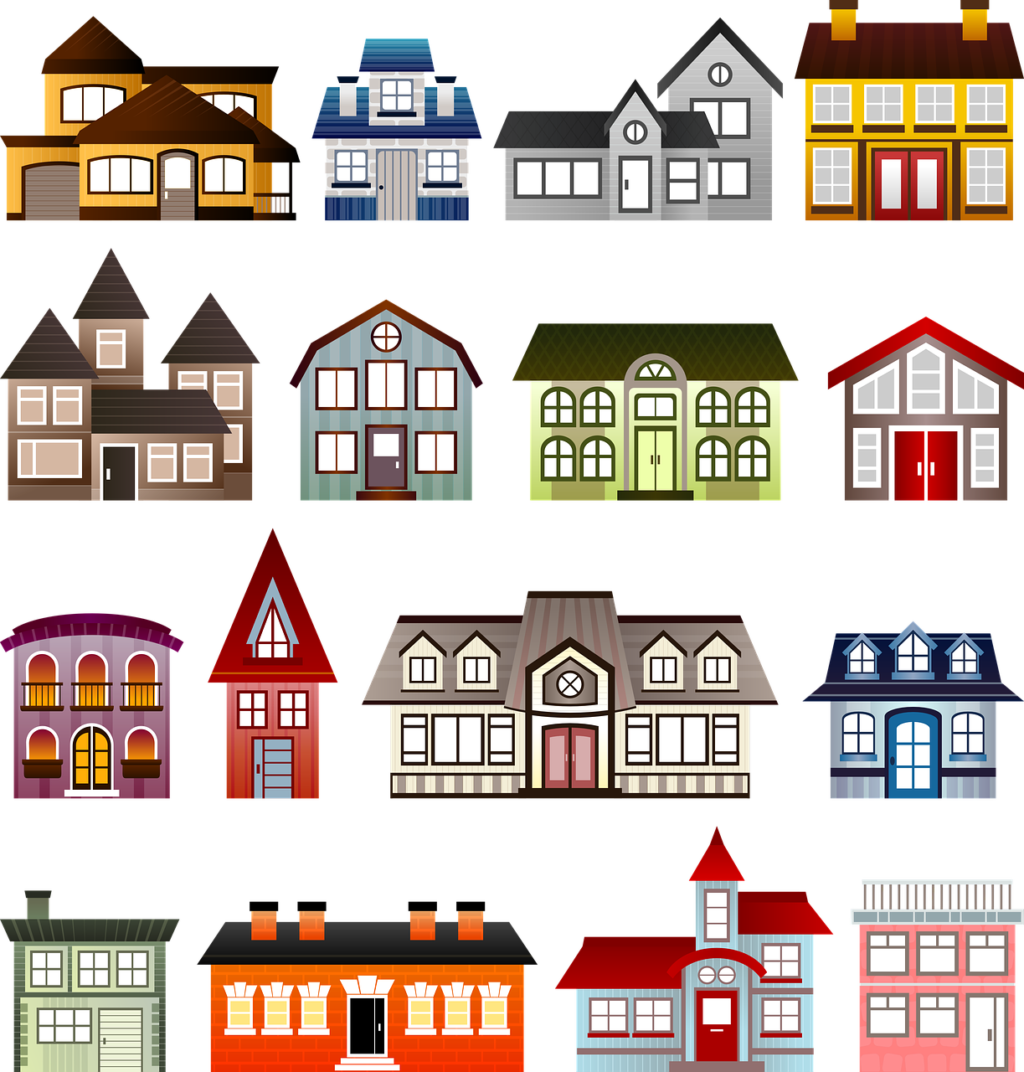
Photo: pixabay.com. Creative Commons
This column appeared previously in the Amherst Current and is reposted here with permission of the author. It may not be reproduced elsewhere without the author’s permission.
In 1984, I bought my house near the middle school for $66,000. It is now worth about $470,000, a sevenfold increase.
This increase in house prices has been great for the net worth of homeowners like me. But I believe it has had negative consequences for Amherst as a community.
The median sale price of a single-family house this year has been an eye-popping $603,000, compared to $300,000 in 2012, according to the Barrett Group, the consultants hired to address our housing challenges. The median condominium price is now $318,750, way up from $153,375 in 2011.
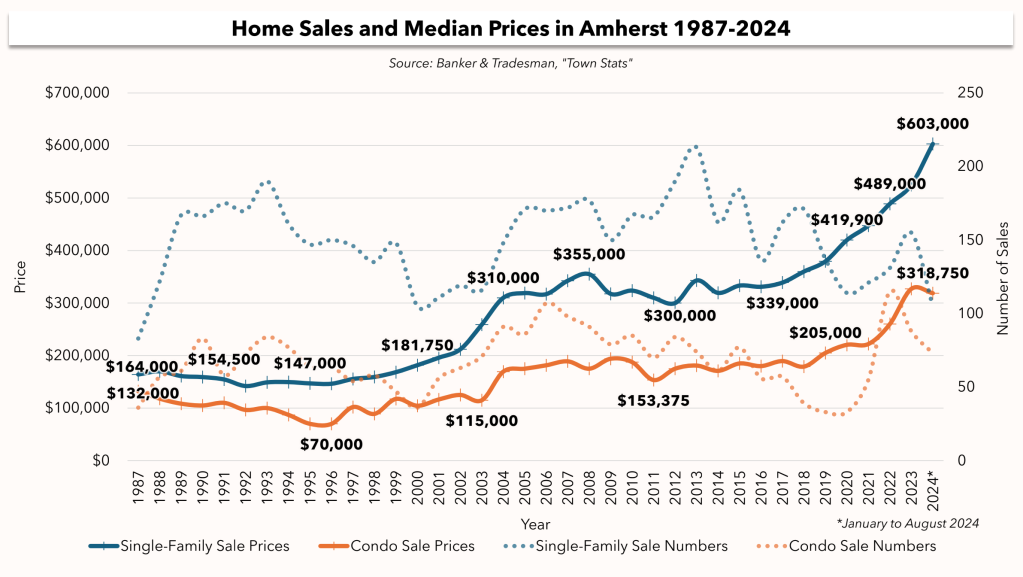
Rents have gone way up, too. I reviewed the first 35 ads for Amherst rentals on the UMass off-campus housing site and found that they averaged $1,220 per bedroom. A studio apartment at One East Pleasant goes for $1,930 a month.
Here are some problems that this inflation in housing costs has created:
The rich get richer… Homeowners, who are more likely to be white and well off, are accumulating wealth, while renters, who are more likely to be students and/or people of color, are paying higher rents without building equity. The average annual income for homeowners in Amherst is $137,102, while for renters it’s $37,617, a much wider disparity than in Massachusetts as a whole, according to the consultants.
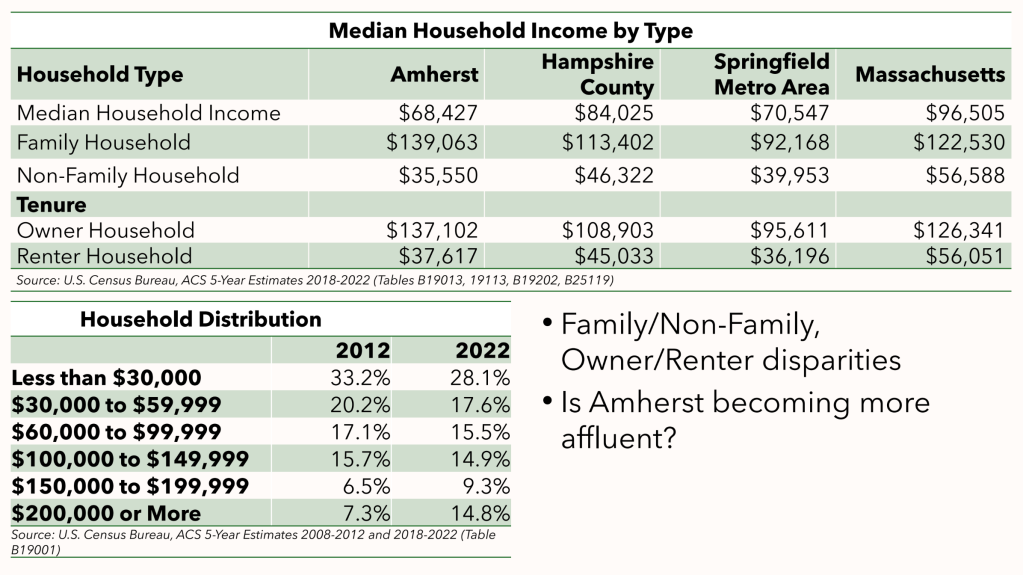
Young families are shut out. It has become very difficult for young couples to afford a single-family house in Amherst. While the over-65 Amherst population has grown from 6.6 percent in 2000 to 10.2 percent in 2020, the number of students in the public schools has dropped by 40 percent (from 3,648 to 2,193), according to the consultants. Charter schools and demographic trends have also contributed to the enrollment decline.
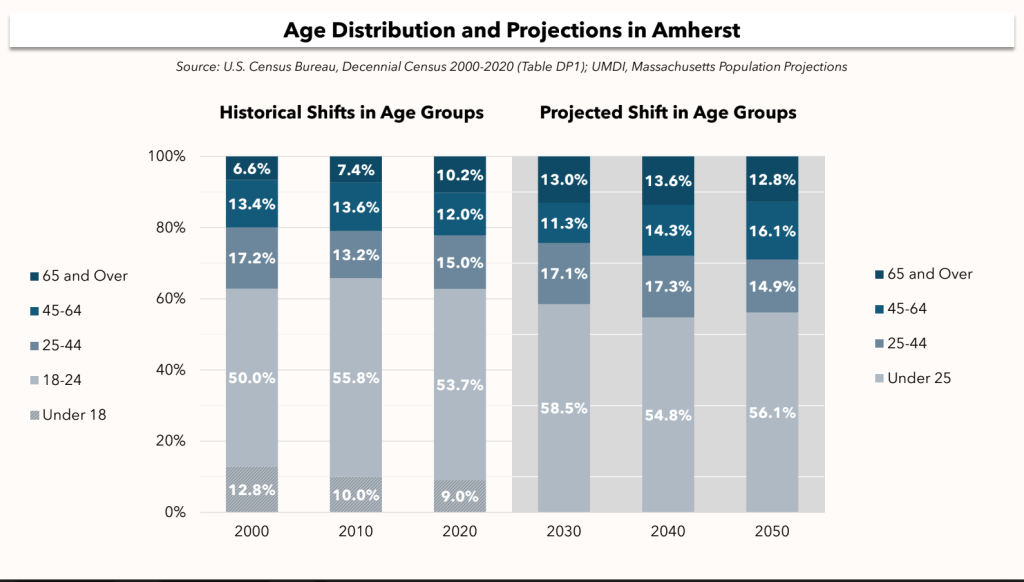
Struggling students and service employees. Twenty-eight percent of the households in Amherst are “severely cost-burdened,” meaning they spend more than 50 percent of their incomes on rent, according to the consultants. Some UMass students, unable to find housing in Amherst they can afford, have looked for apartments in Easthampton or Springfield. Wait staff and retail workers often have long commutes and/or crowded living spaces.
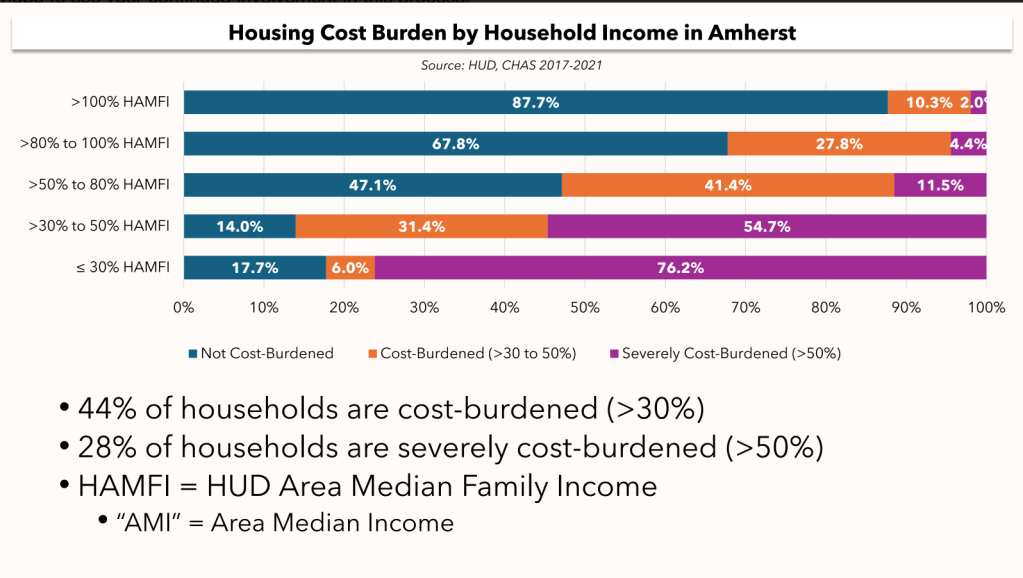
Social stratification. It becomes more difficult for Amherst to see itself as a unified community when the gap between homeowners and renters is wide and widening. While the Survival Center has met a much greater need for free food, Amherst households with annual incomes over $150,000 are now 24.1 percent of the population, up from 13.8 percent in 2012, according to the consultants.
Budget pressure. It has become more challenging for people who work at Town Hall or the public schools to afford a place to live in Amherst. So it’s not surprising when their unions advocate for pay increases. When they are granted, it becomes more difficult to keep the town’s budget within its limits and to avoid asking residents to raise their already-high taxes.
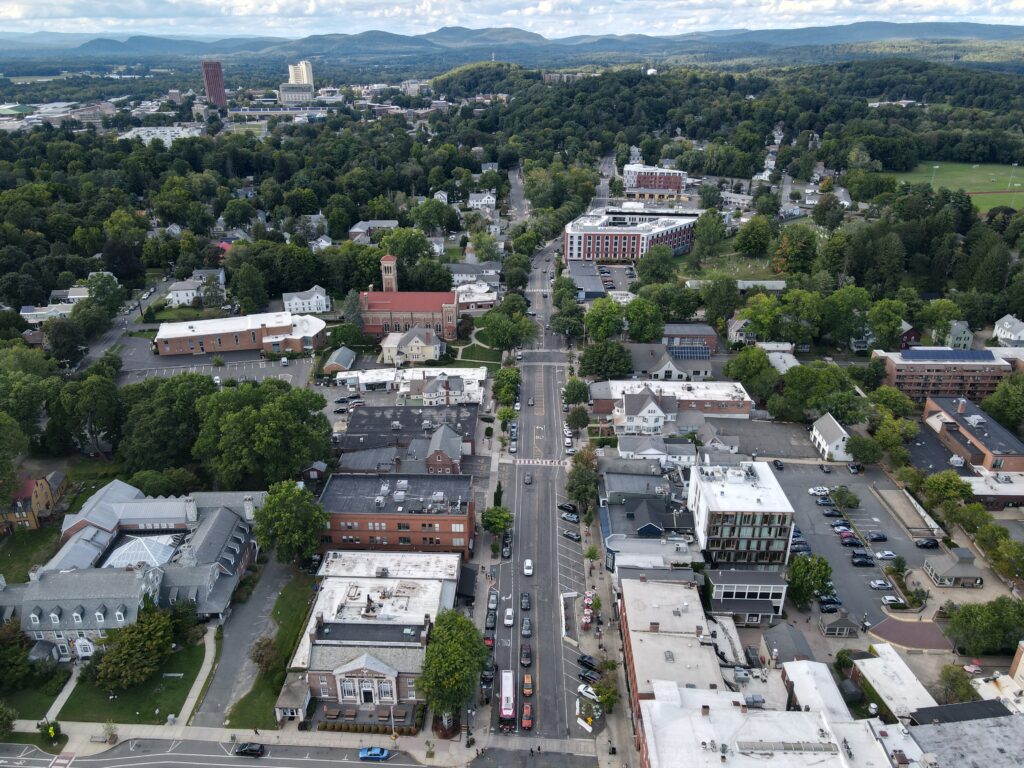
These problems are not new. “There is an overwhelming consensus among those living, working and wanting to live in Amherst that there is a critical need for increasing access to affordable housing, both for rentals and home ownership,” according to a summary of a listening session held last year.
Housing expert Connie Kruger addressed the price gap, the “missing middle,” and a housing proposal before the Town Council in this Amherst Current post. She reported here about the new state law prohibiting towns, including Amherst, from requiring owner occupancy for Accessory Dwelling Units. State action may be necessary to overcome local governments’ resistance to zoning changes designed to make housing more attainable.
The Barrett Group has been conducting interviews about housing, and they plan to do an online survey this month. The consultants will organize focus groups on “implementation strategies” in January, and are due to provide a final “housing production plan” in April, when the public can review it.
What the market dictates for developers and what’s actually needed are not the same, said consultant Judi Barrett. “There are too many needs competing for the same inadequate supply,” she said at a public presentation Oct. 1.
These higher prices are probably the new normal. Like property taxes, house prices seldom go down. Even in the subprime mortgage crisis of 2008, when average U.S. house prices declined by over 20 percent, in Amherst they held steady.
Barrett outlined some changes since the housing plan was updated in 2013: Amherst has more higher-end apartments, more investors are buying houses and converting them to student rentals, more students are living off campus, and young families and the work force face increased housing challenges. UMass has 4,213 more students than it did in 2010.
Meanwhile, construction costs have soared in the past five years, making it extremely difficult to build affordable housing without governmental subsidies.
Because Amherst has little available land that’s suitable for development, the most commonly voiced response to housing scarcity is increased density. But neighbors often resist, and have gotten good at resisting, said former Select Board Chair Elisa Campbell at the October 1 meeting. Former Town Meeting Moderator Francesca Maltese articulated a key question: “How dense can we allow Amherst to be and still be a nice town?”
Amherst has been making some progress lately, with plans for lower-cost housing at the former East Street School, the former VFW building on Main Street, and on Ball Lane in North Amherst.
The Affordable Housing Trust drafted an ambitious “action plan” in September. It included the creation of 200 homes, for rent or ownership, over the next five years. The draft plan proposed finding $4 million to support this effort, perhaps through a 3% “community impact fee” on short-term rentals, a real estate transfer fee, and a contribution from the Community Preservation Act fund.
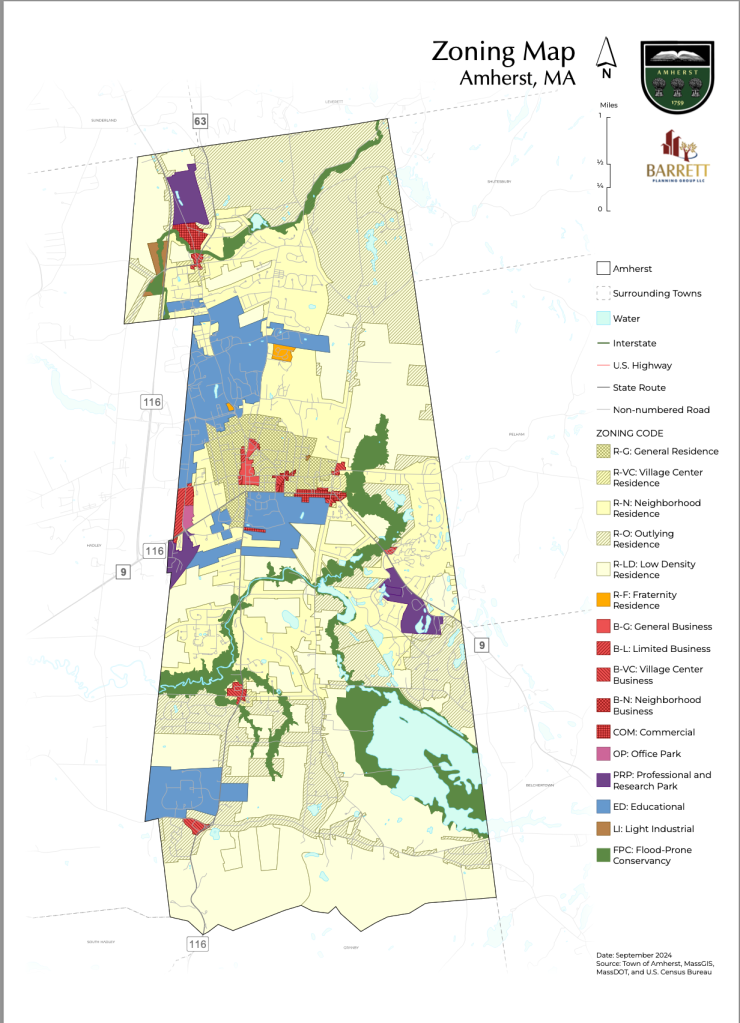
Amherst is not likely to abolish single-family zoning to increase density and affordability, as Minneapolis did. But many other strategies were voiced at last year’s listening session, all with pluses and minuses. They included subsidized rents, getting UMass to build more on-campus housing, rent control, tiny houses, disincentives for turning homes into student rentals, a tax on college meals, and banning Airbnbs. Here’s a link to more details.
Amherst’s zoning map shows districts that are known by acronyms, such as RG (General Residence) and BL (Limited Business), each with their own development rules. A frustrated wag once said that Amherst should create a new zoning district where all kinds of development would be allowed. It would be called SEN, which stands for Someone Else’s Neighborhood.
It’s easy to say that Amherst needs the build more housing. But it can be hard to convince residents to support changes that would allow that to happen.
Nick Grabbe is a co-founder of The Amherst Current. He has been a resident of Amherst for nearly 40 years and served as writer and editor for the Amherst Bulletin and the Daily Hampshire Gazette 1980-2013.

I bought my first building lot in Amherst Woods for $17,500 in 1981. It was the only lot that Jeff Flower sold that year.
I bought my last lot in 2008 for $175,000 having built over 50 homes in that time, it was a great place to do business.
Build out happens, …build up is the solution.
“ The average annual income for homeowners in Amherst is $137,102,”
No wonder I’m struggling.
Thank you Mr. Grabbe. Our housing issues are the culmination of countless decades of poor decision making.
A very useful article, but there are many special factors that affect Amherst housing. First, it is a “college town,” with tens of thousands of students living in or nearby. That distorts the economic statistics: students usually have very limited income, but their families (or lenders) support their expenses. I suspect that explains the “posh” private student housing that has expanded.
Second, Amherst is not an island in the ocean. Living in surrounding communities is an option for all. Often costs are lower. The PVTA does a pretty good job of making commuting to UMass (etc.) cheap and easy.
Third, new housing is simply expensive. The essay points this out, but land, building materials, higher code standard, etc. make unsubsidized construction expensive.
The experience of “public housing” is mixed: lack of management and maintenance has destroyed more public housing than the German Luftwaffe did in World War II!
Has anyone really considered the town should be spending less? Lowering the property taxes?
Whether or not people want to believe this….Taxes are driving people away. Downtown is a disaster. Why would anyone shop there? Coffee and pizza, but what else? Perhaps a visit to the multimillion library site?
Maybe more has to be done to make it “business friendly”? Encourage economic growth, do not discourage it.
Over the past ten years, lots of new apartment buildings have been constructed to improve the housing situation. The owners pay very high property taxes, but not much seems to have helped our town economy. The higher the costs to the owner, the higher the rents.
People who have owned homes here and paid the incredibly high property taxes, for years and years, actually may be “entitled” to improved property values. Many of these people give more than take. They also pay Massachusetts Income Taxes.
It is actually very difficult for me to believe I may be the only taxpayer that feels like this. “ It is always easier to spend someone else’s money.”
“ Has anyone really considered the town should be spending less? Lowering the property taxes?”
Yes, for many years now.
“ It is actually very difficult for me to believe I may be the only taxpayer that feels like this. ”
You are not alone.
As long as Amherst residents who bought in cheap maintain the falsehood that eliminating some areas of single-family zoning will make Amherst a “less nice town,” or whatever the metric is, rental burdens will continue to increase, and local (as in family run) developers will continue to dominate both the residential and commercial markets. This is true in every college town. Keeping the status quo is going to tank the tax base and continue the degredation of the public school system, lowering the quality of life even if the now million dollar homes maintain their value for new higher income residents. As we saw from the Amherst College faculty reaction to the proposed ten units of supportive housing that were proposed “near the school’s track,” “inclusion” is a nice buzzword but when it comes to actually making local structural change, very few are actually onboard when it comes to housing. If my 66k investment gave me 40 years of shelter and 10k a year profit, I’d be concerned too about ruining my investment. But creating an off-ramp from single family zoning is a policy problem, not a barrier. This sort of change will only occur if the student population organized, registered to vote in Amherst, and strategized toward these changes. Current electives have not presented any structural proposals that will help reign in the housing market in Amherst, because if they did, homeowners will vote them out. Who of the homeowners here is scared of density, of demographics shifts in Amherst, if you were to be honest? Would you be open to a change in zoning that takes into consideration your investment, while providing young families entry into the housing market, increasing the quality of schools and the tax base? I think we need to know which homeowners are willing to come to the table, and who will simply resist all change. And how many single family homes are owned exclusively by Amherst College trustees, in relation to the full stock of housing? If a high percentage, that artificial restriction is probably a disaster to forming a stable market.
Mr. Monaco, spoken like the owner of an LLC.
Year round residents are not scared of density or diversity. They just don’t want their downtown or neighborhoods progressively taken over by student housing. Every home housing students means one less family in my neighborhood. One less family with kids to play with each other here and one less family who is invested in the future of the neighborhood.
You don’t need to be an LLC to recognize that Mr Monaco and previous commenters are right. Low income families like mine know that they make very good points. Also, great article, Nick!
The business of Amherst is higher education, but the “ancillary” or “place-based” industry that profits from it is student housing. A business that should be taxed as a business- but isn’t- is hurting our tax base and eroding our housing supply for families and other non-student groups. I know there are legalities in making that happen, but some kind of PILOT or fee would help fulfill one of the benefits of having such an industry in your town, to have a multiplier effect on our tax base, so we can get our public projects done and our roads repaired. Does rent paid to student landlords not get reported as business income? That income is produced in a business location, aka every student rental house in Amherst that is not owner occupied.
I don’t understand what he wants to do? Maybe he could elaborate on the plan he has. But to answer his question, I’m already surrounded by too many students, which equals too many vehicles and too much noise so no, I don’t want more of that! Since this situation has only increased over our 45 years here and just families have been lost, I don’t think the current trend is the answer that lowers taxes since they only go up every year.